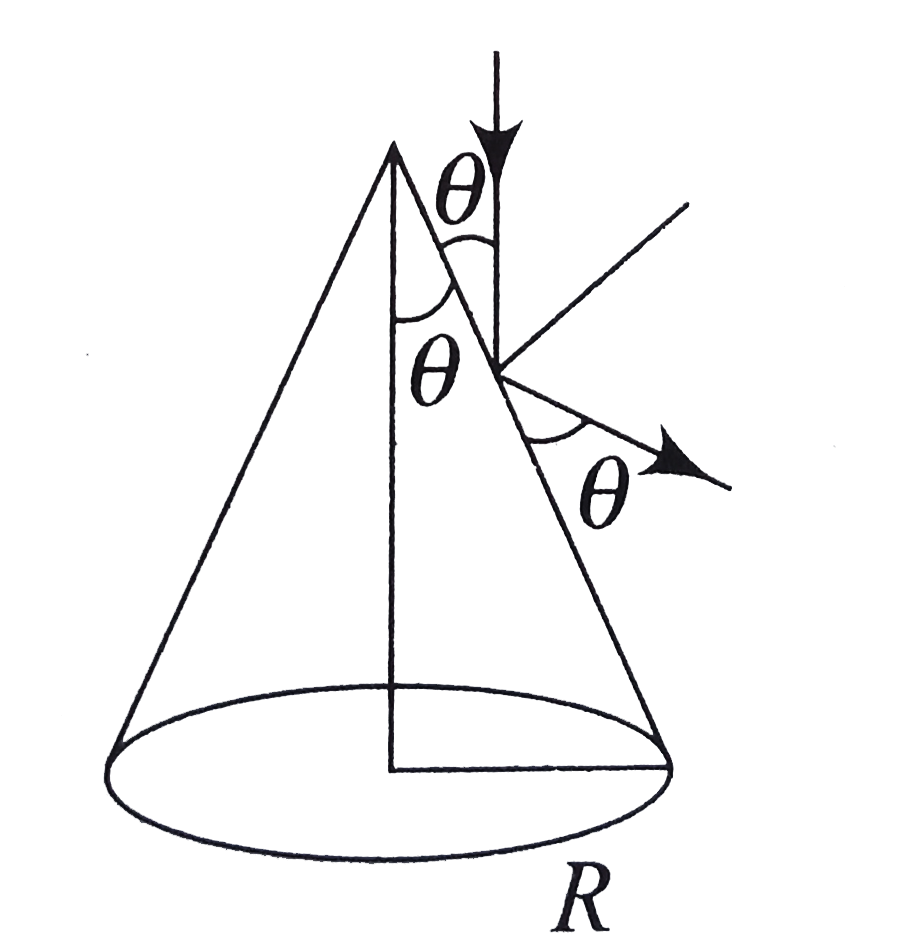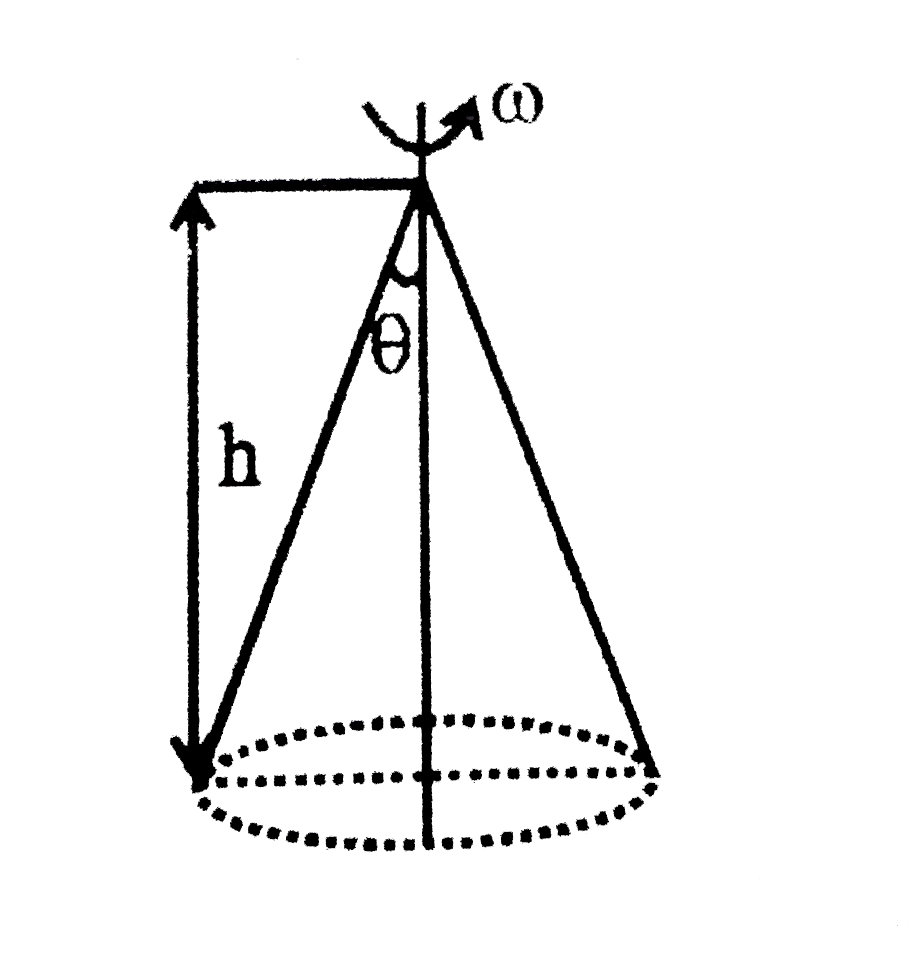Light of intensity I falls along the axis on a perfectly refleccting right circular cone having semi-vertical angle θ and base radius R. If E is the energy of one photon and c is the speed oh light, then find
Q. the number of photons hitting the cone per second
πR2I2E
2πR2IE
πR2I4E
πR2IE
The correct Answer is:D

Power of light received by the cone =(πR2)
Let number of photons hitting the cone per second is n.
Then, nE=IπR2⇒n=πR2IE
By symmetry, the net force on the cone will be vertically downward.
Force due to one photon:
f=2hλsinθ
This force is perpendicular to the surface of cone. Hence, net force on the cone will be
F=nfsinθ=n(2hλsinθ)sinθ
=πR2Ic(1−cos2θ)
Topper's Solved these Questions
- PHOTOELECTRIC EFFECTBOOK - CENGAGE PHYSICSCHAPTER - PHOTOELECTRIC EFFECTEXERCISE - Integer
9 Videos
- PHOTOELECTRIC EFFECTBOOK - CENGAGE PHYSICSCHAPTER - PHOTOELECTRIC EFFECTEXERCISE - Single Correct Answer Type
7 Videos
- PHOTOELECTRIC EFFECTBOOK - CENGAGE PHYSICSCHAPTER - PHOTOELECTRIC EFFECTEXERCISE - Multiple Correct
10 Videos
- NUCLEIBOOK - CENGAGE PHYSICSCHAPTER - NUCLEIEXERCISE - QUESTION BANK
59 Videos
- RAY OPTICSBOOK - CENGAGE PHYSICSCHAPTER - RAY OPTICSEXERCISE - DPP 1.6
12 Videos
Similar Questions
The radius of the base of a right circular cone of semi-vertical angle α is r . Show that its volume is 13πr3 cotα and curved surface area is πr2 coses α.
View SolutionViolet light (λ=4000A)of intensity 4wa/m2 falls normally on a surface of area 10cm×20cm.Find (i) the energy received by the surface per second.(ii) the number of photons hitting the surface the surface per second,(iii) If surface is titled such that plane of the surface makes an angle 30∘with light beam, find the number of photons hitting the surface per second.
View Solution
Knowledge Check
Light of intensity I falls along the axis on a perfectly refleccting right circular cone having semi-vertical angle θ and base radius R. If E is the energy of one photon and c is the speed oh light, then find
Q. the number of photons hitting the cone per secondA(πR2I)c(1−cos2θ)B(πR2I)2c(1−cos2θ)C2(πR2I)c(1−cos2θ)D(πR2I)2c(1+cos2θ)A light of intensity 16 mW and energy of each photon 10 eV incident on a metal plate of work function 5 eV and area 10−4m2 then find the maximum kinetic energy of emitted electrons and the number of photoelectrons emitted per second if photon efficiency is 10%.
A5 eV, 1011B10 eV, 1012C5 eV, 1013D10 eV, 1014An electron & a photon have same energy E. Find the ratio of de Broglie wavelength of electron to wavelength of photon. Given mass of electron is m & speed of light is C
A1C√E2mBC√EmC1C√2mED1C√Em
A source emits monochromatic light of frequency 5.5×1014 Hzat a rate of 0.1 W. Of the photons given out, 0.15% fall on the cathode of a photocell which gives a current of 6μA in an extrnal circuit.
(a) Find the enrgy of a photon.
(b) Find the number of photons leaving the source per second.
(C) Find the percentage of the photons falling on the cathode which produce photoelectrons.
View SolutionQ charge is uniformaly distributed over the same surface of a right circular cone of semi -vertical angle theta and height h The cone is uniformly rotated about its axis at angular velocity omega Calculated associated magnetic dipole moment
 .
.
View Solution(a) Find the maximum frequency of the X-rays emitted by an X-ray tube operating at 30kV.
(b) An X-ray tube operates at 20kV. A particular electron loses 5% of its kinetic energy to emit an X-ray photon at the first collision. Find the wavelength corresponding to this photon.
(c ) An X-ray tube is operated at 20kV and the current through the tube is 0.5mA. Find
(i) the number of electrons hitting the target per second,
(ii) the energy falling on the target per second as the kinetic anergy of the electrons and
(iii) the cut-off wavelength of the X-rays emitted.
View Solution(a) A parallel beam of monochromatic light of wavelength 500 nm is incident normally on a perfectly absorbing surface. The power through any cross section of the beam is 10 W. Find
(i) the number of photons absorbed per second by the surface and
the force exerted by the lilght beam on the surface.
(a) Radiation of wavelength 200 nm, propagating in the form of a parallel beam, fall normally on a plane metallic surface. The intensity of the beam is 5 mW and its cross-sectional area is 1.0mm2. Find the pressure exerted by the radiation on the metallic surface if the radiation is completeley reflected.
(c) A parallel beam of monochromatic light of wavelength 663 nm is incident on a totally reflecting plane mirror. The angle of incidence is 60∘ and the number of photons striking the mirror per second is 1.0×1019 . Calculate the force exerted by the light beam on the mirror.
(d) A beam of white light is incident normally on a plane surface absorbing 70%) of the light and reflecting the rest. If the incident beam carries 10 W of power, find the force exerted by it on the surface.
View SolutionUltraviolet light of wavelength 300nn and intensity 1.0Wm−2 falls on the surface of a photosensitive material. If one per cent of the incident photons produce photoelectrons, then the number of photoelectrons emitted per second from an area of 1.0 cm2 of the surface is nearly
View Solution